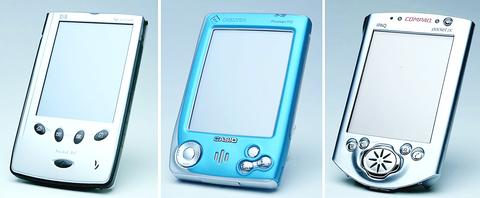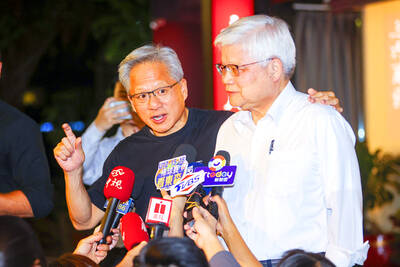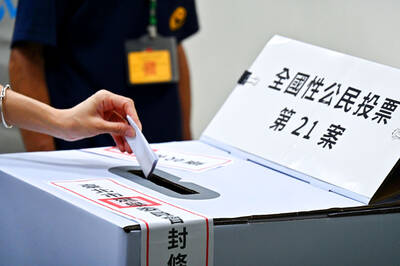Part of the agony and the ecstasy of being human is our ability to confront the big questions. What's the meaning of existence? Is there life after death? And which is better: the Palm or the Pocket PC?
Of course, that last question isn't really fair. It's like asking, "Which is better: a mango or a shoehorn?" The two palmtop families were designed for completely different purposes. Palms and Palm compatibles are small, fast, simple, inexpensive organizers meant to keep your calendar and addresses synchronized with your computer. A Pocket PC is Microsoft's effort to shrink a complete Windows PC into a tiny slab, complete with color, sound and expansion slots, closer to a laptop than a calculator.

PHOTO: NY TIMES
Microsoft's early attempts at its mobile operating system, called Windows CE, were disastrous. The company's usual design approach prevailed -- the more features, the better -- and big, complex, expensive and wildly unpopular palmtops that Microsoft called Palm-sized PC's were the result. Still, Microsoft soldiered on with refinements, as it often does in the face of failure.
In its third attempt, the company has devised a palmtop design that's genuinely useful and increasingly popular. About 1.25 million people have bought what Microsoft has renamed Pocket PC devices. With 12 million in circulation, the Palm operating system still far outsells its rival, but Pocket PC is gaining.
What technophiles love about Pocket PCs is that they do more than Palms and Palm-compatibles. The feature list would stretch to Bill Gates' house and back 23 times. Chief among their assets are bright, beautiful color screens that dwarf the standard Palm screen: 240 by 320 pixels, versus 160 square. (You have to wonder why Palm can't buy the same magnificent screens for use in its palmtops; surely Pocket PC makers aren't the only ones with access to the Singapore Yellow Pages.)
A microphone for voice memos is also standard Pocket PC equipment. Using the speaker or stereo headphones, you can also listen to MP3 files (but budget a few hundred dollars for memory-expansion cards to hold them). Pocket PCs come with more built-in memory, too; the bestselling Compaq iPaq 3600, for example, comes with up to 64 megabytes (although Windows itself sucks away 5 of them). A Pocket PC comes with a power cord, too. That's fortunate, because the battery charge is notoriously short -- six or seven hours.
Lots of cool software is built in, including stripped-down versions of Word, Excel and Internet Explorer -- the bread, butter and wine of corporate America. There's even a tiny version of Windows Media Player, which can play movies. (Short movies, that is. Don't buy the hype about using your Pocket PC as in-flight entertainment unless you're flying only from Times Square to Central Park.)
All of these features are available for the Palm OS, too, but no one model comes with all of them built in. Even so, Palms and Palm-compatibles outsell Pocket PCs for some good reasons. Pocket PCs are still bigger and heavier; don't expect to carry yours in a shirt pocket unless you're wearing overalls. Remember, too, that the Pocket PC has only 10 percent of the market, and therefore fewer companies have designed add-on programs and accessories for it. (Microsoft is learning what it's like to be Apple.)
But the biggest problem is Windows CE itself. It shares too many genetic traits with Windows Sr, including occasional freezes, cryptic error messages, frequent appearances of the "wait" cursor and a ludicrous requirement to manually shut down programs when the going gets sluggish.
If you're coming from a Palm, Windows CE can also be hard to navigate, especially at first. When you use a Palm, you feel as if you've been seated at a tidy four-drawer desk. When you use a Pocket PC, you feel as if you've been dropped off at the Mall of America. There are so many programs on board that they don't even fit on a single screen; to see them all, you have to open the Start menu, then tap Programs, and then tap through several category screens to see their icons.
Perhaps the easiest way to understand the difference between the Palm and Windows CE philosophies is to count the number of steps a given task requires. When checking your battery level, the Palm wins, one tap to four. When setting up a no-start-time event like a birthday, it's Palm one, Microsoft three. When changing a to-do item's priority, it's Palm two, Microsoft five.
You can't simply write a new appointment onto a Windows CE calendar screen, as you can on a Palm; you have to open a dialog box first. A Palm is always ready to receive information beamed by infrared; on the Pocket PC, you have to run an IR Receive program to make your palmtop "listen."
That's not to say that Microsoft hasn't come up with some brilliant touches. For example, the backlight automatically dims to save power and pops back on when you touch the screen. The handwriting-recognition alphabet is much more natural than Palm's Graffiti.
If you decide that a Pocket PCs rich feature list outweighs its bulk and complexity, you can choose from several attractive models. At the top of the charts is the Compaq iPaq 3600, a silver-clad beauty whose bright, beautiful screen helps explain why this model is perpetually out of stock. Bulky, optional external sleeves can accommodate PC cards or Compact Flash cards for wireless networking or wireless Internet. The iPaq is also the fastest Pocket PC, but beware its price: US$600 for the 32-megabyte model, US$650 for 64 megabytes.
But you shouldn't necessarily buy into the iPaq hysteria. The screen on Casio's Cassiopeia M-500, for example, is more colorful (65,536 colors, compared with the iPaq's 4,096) and even brighter, well suited for use as a reading light at the theater. This US$400 machine costs much less than the iPaq, has a built-in slot for multimedia cards (though not the more useful Compact Flash cards) and has a better speaker. Only the Cassiopeia's rechargeable battery is removable, making this model the only candidate for two-week safaris (or two-day business trips, for that matter).
On the other hand, the Cassiopeia's 16 megabytes of memory is barely enough, and its buttons are precisely where the right-hander's fist rests when writing on the screen, triggering inadvertent program switching.
Hewlett-Packard's Jornada 548 (US$550 with 32 MB of memory) mimics the layout of a Palm, with the same four buttons across the bottom and, mercifully, the same slim width, which makes this unit fit more comfortably than its rivals into the non-pianist's hand. The built-in Compact Flash slot accommodates a wide variety of add-ons, including a digital camera. As a bonus, the high-end 548 comes with a sleek protective flip lid -- an essential feature -- that's lacking on the iPaq and the Cassiopeia. If it weren't for its 4,096-color, slightly dingy screen, the 548 would be the perfect Pocket PC. Carry an umbrella on sunny days; the 548s screen, like Casio's, becomes nearly invisible outdoors.
If you're counting pennies, you can get the US$360 Jornada 325, the cheapest Pocket PC available. Unfortunately, so many corners have been cut, the thing might as well be a sphere. The 256-color screen is pale; the PC connection cable uses a slow serial connection (not the much more convenient USB); and incredibly, there's no slot for the stylus.
Of course, a freshly unpacked Pocket PC can't talk to a Macintosh, but a Mac connection kit will soon be available from DoctorCE.com. That's not the only way the lines between Palms and Pocket PC's are beginning to blur. Already, some Pocket PC's are starting to sink into the traditional Palm price range; the grayscale iPaq costs US$300. If you want a Palm with a big, Pocket PC-like rectangular screen and a built-in voice recorder, you can get a HandEra 330.
Soon enough, you'll be able to choose your own spot on the simplicity-features spectrum within either camp; after that, life's other questions will seem like a piece of cake.

Chinese Nationalist Party (KMT) lawmakers have declared they survived recall votes to remove them from office today, although official results are still pending as the vote counting continues. Although final tallies from the Central Election Commission (CEC) are still pending, preliminary results indicate that the recall campaigns against all seven KMT lawmakers have fallen short. As of 6:10 pm, Taichung Legislators Yen Kuan-heng (顏寬恒) and Yang Chiung-ying (楊瓊瓔), Hsinchu County Legislator Lin Szu-ming (林思銘), Nantou County Legislator Ma Wen-chun (馬文君) and New Taipei City Legislator Lo Ming-tsai (羅明才) had all announced they

CHAMPIONS: President Lai congratulated the players’ outstanding performance, cheering them for marking a new milestone in the nation’s baseball history Taiwan on Sunday won their first Little League Baseball World Series (LLBWS) title in 29 years, as Taipei’s Dong Yuan Elementary School defeated a team from Las Vegas 7-0 in the championship game in South Williamsport, Pennsylvania. It was Taiwan’s first championship in the annual tournament since 1996, ending a nearly three-decade drought. “It has been a very long time ... and we finally made it,” Taiwan manager Lai Min-nan (賴敏男) said after the game. Lai said he last managed a Dong Yuan team in at the South Williamsport in 2015, when they were eliminated after four games. “There is

Nvidia Corp CEO Jensen Huang (黃仁勳) yesterday visited Taiwan Semiconductor Manufacturing Co (TSMC, 台積電), as the chipmaker prepares for volume production of Nvidia’s next-generation artificial intelligence (AI) chips. It was Huang’s third trip to Taiwan this year, indicating that Nvidia’s supply chain is deeply connected to Taiwan. Its partners also include packager Siliconware Precision Industries Co (矽品精密) and server makers Hon Hai Precision Industry Co (鴻海精密) and Quanta Computer Inc (廣達). “My main purpose is to visit TSMC,” Huang said yesterday. “As you know, we have next-generation architecture called Rubin. Rubin is very advanced. We have now taped out six brand new

POWER PLANT POLL: The TPP said the number of ‘yes’ votes showed that the energy policy should be corrected, and the KMT said the result was a win for the people’s voice The government does not rule out advanced nuclear energy generation if it meets the government’s three prerequisites, President William Lai (賴清德) said last night after the number of votes in favor of restarting a nuclear power plant outnumbered the “no” votes in a referendum yesterday. The referendum failed to pass, despite getting more “yes” votes, as the Referendum Act (公民投票法) states that the vote would only pass if the votes in favor account for more than one-fourth of the total number of eligible voters and outnumber the opposing votes. Yesterday’s referendum question was: “Do you agree that the Ma-anshan Nuclear Power Plant